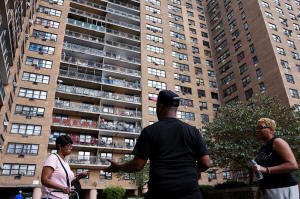As U.S. heat deaths rise, some landlords oppose right to air
conditioning
 Send a link to a friend
Send a link to a friend
 [August 05, 2024]
By Gloria Dickie [August 05, 2024]
By Gloria Dickie
August 5 (Reuters) - Summers in New York City are difficult for Anthony
Gay and his family. A small, portable air conditioner in his bedroom is
the only relief they have from soaring temperatures in their Brooklyn
rental.
"The rest of the apartment is literally unbearable to walk through,"
said Gay, 40, whose asthmatic son struggles to breathe in the heat.
Heat can be a killer. An estimated 350 New Yorkers die prematurely each
year because of extreme heat, according to the city's 2024 Heat-Related
Mortality Report. Lack of access to air conditioning at home is the most
important risk factor in such deaths, it said.
Yet, across the United States, about 12 percent of homes – or about 12.7
million households – had no access to air conditioning in 2020,
according to the most recent government data. Many more had some air
conditioning, like Gay, but not enough to beat the heat.
Most often, homes with little or no air conditioning are occupied by
low-income residents – often renters — and people of color, a 2022
Boston University analysis of 115 U.S. metro areas found.
That leaves them vulnerable as climate change makes heatwaves more
frequent, more intense and longer lasting. Heat stress now kills more
people globally each year than any other weather-related cause,
according to the World Health Organization — and many of these deaths
occur indoors.
A Reuters survey of housing regulations in all 50 U.S. states found
that, while nearly half of them require landlords to maintain existing
air conditioning units, none require that air-conditioning be provided.
Nor do rental housing regulations describe air-conditioning as an
essential service like plumbing, heat and electricity.
However, a small but growing number of U.S. states, cities and counties
have adopted legislation that impose maximum indoor temperature
standards on rental housing.

In the last five years, six U.S. localities, including New Orleans and
Clark County, Nevada, have adopted such cooling laws, compared with just
seven in the previous two decades, according to Reuters' review of
property codes and interviews with more than a dozen policymakers and
housing officials.
Now, America's two largest population centers – New York City and Los
Angeles County — as well as Austin, Texas, are proposing new indoor
temperature maximums for renters.
New York is proposing a cap of 78 Fahrenheit (26 degrees Celsius), and
Austin is considering 85 Fahrenheit (29 C), while L.A. County has yet to
formalize its target. New York City and Austin's proposals would require
that landlords install cooling systems, given the difficulty of
retrofitting old building stock to allow for better air flow and other
passive measures.
The moves are setting up a showdown with powerful landlord lobbies.
Similar bills in other jurisdictions — California, Texas and Hot
Springs, Arkansas — have failed in recent years after landlords' groups
told policymakers they would need to raise rents to compensate for the
costs of upgrading home electrical systems and adding air conditioning.
The California Apartment Association landlord lobby does not support a
cooling mandate "until we can find a way to make sure that we don't
knock out our electrical system and make the cost so exorbitant," said
Debra Carlton, the group's executive vice president of state public
affairs.
A 2022 statewide bill died following landlord push back. The California
Legislature instead asked state experts to craft recommendations, which
were published this June, suggesting an indoor maximum of 82 F (28 C)
for newly-constructed units only.
A law in New York City might have a better chance as Mayor Eric Adams
made establishing a summer indoor temperature policy by 2030 one of the
goals for his administration. His office remains "committed" to the 2023
plan, a City Hall spokesperson told Reuters.
A bill proposed in July would require rental homes be kept at 78 F or
lower once outside temperatures hit 82 F or above – a regular occurrence
during New York summers.
If approved, the measure would impact some 750,000 renters who do not
have air-conditioning, according to Council member Lincoln Restler, who
sponsored the bill.
"There's an urgency to this legislation," he said. "Heat is the No. 1
climate killer, and it's only getting worse."
Restler said the bill would allow 4 years for landlords to make energy
efficiency and electrical upgrades.
A MATTER OF LIFE AND DEATH
While air conditioning accounts for about 4 percent of the world's total
greenhouse gas emissions, which fuel climate change, research shows it
also saves lives. A 2016 study estimated a 75 percent drop in the number
of U.S. heat-related deaths on hot days during the latter half of the
20th century after AC was introduced, according to findings published in
the Journal of Political Economy.

Heat-related deaths are undercounted globally, epidemiologists say. The
United Nations, in a report this year, said that modelled estimates
suggest that between 2000 and 2019, approximately 489,000 heat-related
deaths occurred each year, with nearly half of those in Asia.
[to top of second column]
|

Anthony Gay converses with his neighbors about his struggle with air
conditioning at 11 McKeever Place in New York City, U.S., July 26,
2024. REUTERS/Kent J. Edwards/File Photo

In the United States, the Centers for Disease Control and Prevention
estimates that heat-related deaths have been increasing, with
approximately 2,302 in 2023 versus 1,602 two years previously.
However, that data only includes death certificates that
specifically mention heat and is regarded by many experts as a
dramatic undercount.
One of the few places to track indoor and outdoor heat-related
deaths is Maricopa County in Arizona, where temperatures regularly
top 110 F (43 C). Despite two of its cities – Phoenix and Tempe –
passing maximum indoor temperature laws, the county registered 156
indoor heat-related deaths last year, a five-fold increase over the
last decade.
Although the trend is bleak, in 2023 Phoenix and Tempe fared better
than cities in the county without cooling laws. Indoor deaths
accounted for 21 percent of Phoenix's heat-related deaths and 17
percent of Tempe's, compared with a county average of 24 percent -
and more than 32 percent in the cities of Scottsdale and Mesa,
public health data showed.
Record-breaking heat waves in recent years have spurred some new
legislation.
Following the 2021 heat dome that hit the Pacific Northwest, the
U.S. state of Oregon in 2022 and Spokane, Washington, in 2024
approved measures to limit landlords' ability to stop tenants from
installing their own air-conditioners over concerns about liability
or utility bills.
But many of America's warmest cities and states are struggling to
pass laws on safe temperatures.
The Arkansas mountain city of Hot Springs last year abandoned a
proposal for cooling standards in rental units after receiving
complaints from landlord groups, said Phyllis Beard, a member of the
city's board of directors.
In an August 2023 email sent to the board, reviewed by Reuters, Hot
Springs landlords said the proposal would "hurt the most vulnerable
in our community by making affordable housing difficult if not
impossible to provide".
Upgrading a single-family U.S. home to a central air-conditioning
system generally costs between $5,000 and $10,000, according to
figures from the American Society of Home Inspectors, while an
in-window unit costs around $400 on top of electrical upgrades for
older homes to support the unit. This can run between $2,000 and
$3,000, the California Apartment Association said.
And while the Texas cities of Dallas, El Paso and Houston have set
indoor temperature standards, a statewide bill stalled last year
after opposition from the Texas Apartment Association, house
representative Sheryl Cole told local media. The city of Austin is
now mulling new rules.

In muggy Florida, Democratic State Senator Jason Pizzo, a real
estate developer, said that he had spoken with Florida landlord
associations and was confident his state would pass an
air-conditioning requirement within the next two years, despite
seeing four previous attempts fizzle since 2021.
Pizzo argued that, with Florida's mold-encouraging humidity,
air-conditioning makes good economic sense, protecting not only a
building's residents but also the building itself: "air-conditioning
is a dehumidifying, property damage-protecting instrument."
The Florida Apartment Association, which says it represents more
than three-quarters of apartment homes in the state, did not respond
to a request for comment.
CLIMATE SHIFT
In L.A. County, the board of supervisors – its five-member governing
body - is expected to vote later this year on a bill that could
impact the county's 3.4 million households, more than half of whom
are renters.
"There once was a time where we realized that people dying of the
cold indoors is something that we needed to regulate," said L.A.
County supervisor Lindsey Horvath who put forward the motion. Many
U.S. jurisdictions require that rental housing can meet minimum
indoor temperatures: California state law stipulates a minimum of 70
F (21 C).
"Now with the way that the climate has shifted, we also have to
think about those higher [temperatures]," she said.
By mid-century, central Los Angeles is expected to experience three
times more days of temperatures above 95 F than it did between 1981
and 2000.
Some California tenant groups worried that passing laws to force
apartment upgrades could lead to evictions followed by higher rents
– as the state's eviction law allows landlords to remove tenants if
a home renovation requires a permit and will take more than 30 days
or is considered "unsafe".
L.A. County landlord associations also said they were gearing up to
fight, and cited reasons from costs to liability to aesthetics.
Poorly installed window AC units "could fall on people," Daniel
Yukelson, executive director of the Apartment Association of Greater
Los Angeles, told Reuters. He also criticized such window units as
"kind of unsightly".
(Reporting by Gloria Dickie in London; Editing by Katy Daigle and
Daniel Flynn)
[© 2024 Thomson Reuters. All rights
reserved.]This material
may not be published, broadcast, rewritten or redistributed.
Thompson Reuters is solely responsible for this content. |